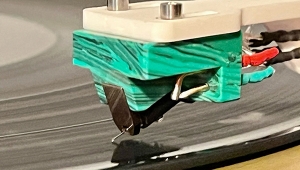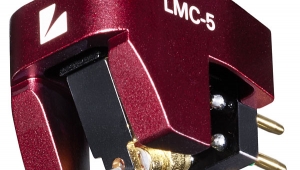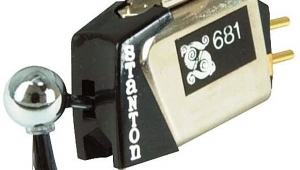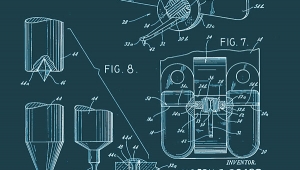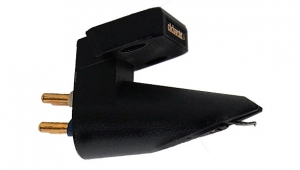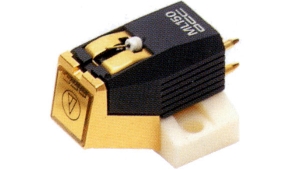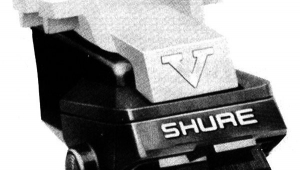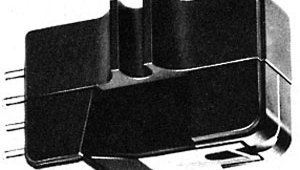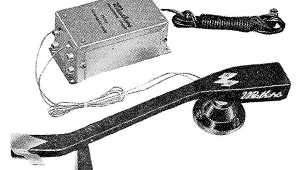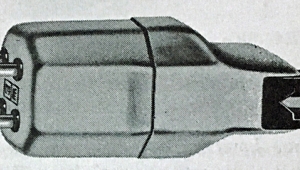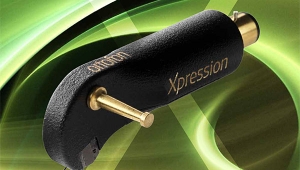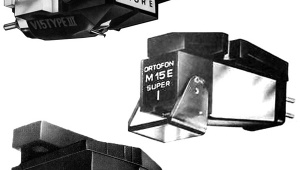| Columns Retired Columns & Blogs |
Lyra Clavis Da Capo moving-coil phono cartridge Page 2
With proper care, your stylus may very well outlast your suspension, though Carr says that if the designer knows what he's doing, you won't have a suspension "time bomb." Speaking of which, now that you have a feel for what makes the cantilever "give," you can understand why it is so critical to lower the stylus into the groove gently. If you drop it repeatedly with force, you'll flex the thin wire suspension beyond its elastic limit and your cartridge may "bottom out."
Footnote 2: I do know that some reviewers who've written about Scan-Tech designs with less-than-enthusiastic prose have used what I consider to be non-rigid, non-damped, and thus non-appropriate tonearms with these hi-tech designs. That strikes me as a prescription for disappointment.
Pole-pieces and magnets
The magnet sandwiched between the cartridge pole-pieces can be samarium/cobalt, neodymium, or some more mundane magnetic material. Its shape and size can also vary.
The purpose of the pole-pieces is to transfer the magnetic flux from the magnet to the gap in a focused fashion, while preventing stray magnetic fields from reaching the coils directly. A short pole-piece results in a greater amount of magnetic energy reaching the gap (thus greater efficiency), which is good. Unfortunately, it also increases the likelihood of stray energy reaching the gap, which is not good because it increases distortion. The inverse is also true; thus, the designer has to find the ideal balance of magnetic strength and distance from the magnet to the gap.
The original Clavis used long pole-pieces and a very strong magnet to generate a reasonably high output signal with extremely low distortion. The Clavis DC, however, offers a radical departure from that scheme in that there are no pole-pieces. There is a similarly shaped structure to anchor the cantilever assembly, but it does not function as a magnetic flux transmitter. Instead, two powerful disc magnets are threaded on the cantilever assembly, with one replacing the back "pole-piece" and one the front "pole-piece." The gap is therefore defined by the magnets, with the flux created by the surfaces of the magnets themselves, not from be directed by the pole-pieces.
But then won't the "stray" magnetic flux increase greatly, thus increasing distortion? Not according to Carr, who claims that two magnets operating in a push-pull, mode with the core in the center, results in both extremely low distortion and the efficient generation of electricity.
No body and soul
The final piece of the puzzle is the cartridge body. While some cartridge manufacturers simply glue the motor assembly to the inside of the top plate, in the original Clavis, it was securely anchored to the base via the screw which sandwiched the pole-piece/magnet assembly.
To accomplish this, the cartridge mounting plate had to be scooped out to accommodate the top of the pole-piece, an extremely difficult machining job. In addition, the original Clavis further strengthened the mechanical integrity of the cantilever assembly by extending the length of the stopper tube and feeding it through the back of the rear pole-piece and into a hole drilled in the rear of the base—another extremely difficult machining job. (If the hole for the stopper tube and the hole for the pole-piece screw don't line up exactly, the entire assembly is unusable.)
The advantage of this design was better energy transfer from the cantilever to the body to the arm. Usually, vibrational energy reflects back down to the stylus tip. The result was said to be better pitch definition and purer-sounding transients. The design also allowed the body to be easily removed after the cartridge was installed, resulting in freedom from body-cavity–induced resonances. [The reduced cartridge mass also might give a better match with the tonearm's effective mass and the cartridge cantilever compliance.—Ed.]
Unfortunately, as Clavis owners discovered, the unprotected motor assembly was more vulnerable to damage, and without a body, there was no way to clip on the stylus guard. In order to do that, you had to replace the body—a somewhat tricky maneuver.
The Clavis DC uses a "monoblock" body and base, in which a single piece of hard-anodized 7075 aircraft-grade aluminum alloy is precision-machined both to accommodate the motor assembly and to provide a mounting base. (In most other cartridge designs, the body is glued or bolted to the base.)
The single-unit, cutaway construction offers freedom from body-cavity–induced resonances, extreme rigidity, and a good deal of protection for the motor assembly. As with the original Clavis, the DC's stopper tube is secured into the rear of the base, but since there is no rear pole-piece, the entire length of the stopper tube fits into the body, thus increasing the mechanical rigidity of the cantilever subassembly .
Clavis DC
It took longer to break this sucker in than any cartridge I've ever used—over a month of constant use. Out of the box, it sounded extremely bright—not harsh, just bright, with an obviously rising top end that shone a spotlight on everything in the upper octaves. I was tempted to load the cartridge down, but since the manufacturer and the importer recommend 47k ohms, that's where I left it.
The Clavis DC demands precise set-up. If you're sloppy with overhang, offset, azimuth, VTA, or VTF, it will rip your head off with a harsh, hard, unforgiving top-end. BUT, once you get it "dialed-in" precisely, it offers superb focus from the very back to the very front of the soundstage and to the outer corners. This is a "lights on" cartridge that illuminates the proceedings with energy to spare, despite its relatively low output.
Once it was suitably broken in, the Clavis DC proved to be a highly analytical, revealing, lean-sounding transducer, with a "lively" top end and an extremely tight, "fast" bottom end. The latter easily revealed the source of the low frequencies the cartridge was reproducing. Drum-skin textures, mallet heads, and bass strings were all defined with tight precision, as were the shapes and materials of the instruments being struck. If your sonic cup of tea is "richness," "warmth," "dying embers romanticism," you won't be happy with the Clavis DC's bottom-end performance—or any other part, for that matter, perhaps with the exception of the midrange, where the DC is essentially neutral, though it doesn't sound "liquid."
Minute changes in tracking force altered the overall sound in not-subtle ways. Ideal tracking force was 1.8 grams—the top of the range. Anything less and the top end began to dominate the picture. I also found that I needed to increase the amount of damping in both the Graham and Rockport arms to achieve a natural timbral balance.
The instruction sheet describes the Clavis DC as "exuberant and exciting," and it ain't kidding. You get the sense that the DC eats whatever energy is put in its way and spits it out the other side with complete abandon. If you (and your playback system) don't get this baby under complete control, it'll run away with your system and steal the music out from under you.
But, if you tame it with careful set-up, you can get it eating out of your hand and purring like a pussy cat. When you do that, you will be rewarded with the sense of a clear path from the master tape to your ears. Not everyone craves reproduction that literal and revealing. Great recordings will give you everything they've got. Unfortunately, so will the stinkers.
On Joan Baez In Concert, there was a sense of Joan standing in front of you in three dimensions—you could see her, and the outline of her guitar, and you felt as if you were listening from the other side of the microphone. The energy just kept coming, as it would if you heard Joan live. The boundary line between her head and the expanse of airy, empty stage behind her was revealed with uncanny precision. You could hear the very weak echo of her voice bouncing off the stage's side wall and you could feel the air circulating on the stage behind her.
The same three-dimensional solidity is evident with Miles Davis's trumpet on the Blackhawk stage, which sounds brassy, and airy, and "live" as Miles moves the horn bell around the mike. It's also totally free from reality-robbing grain and hardness. You'll get this picture only if you've locked the Clavis in with very careful set-up. Anything less and the illusion is destroyed, replaced by the clear sensation that a stylus is scraping through a vinyl groove.
On the Mel Torme album, Mel's voice sounds round and positively mellow, floating on a cushion of air while at the same time locked in three-dimensional focus. You can literally see his lips move, and hear him maneuver the air from his diaphragm through his throat and up to his nasal passages as he changes tonality to drive the songs home.
Mel's backup group is arrayed behind and to his sides, the piano clearly focused to your left, the rhythm section to your right, and behind them, you can make out people sitting at tables and talking. Glasses tinkle, wine corks pop, and liquid is poured. All of this activity continues way in the background as Torme sings. When he's through, the tables come to life with bursts of applause.
This cartridge really reveals what it can do in the way of driving rhythms forward, exposing inner detail and timbral richness, and placing images in space on a gigantic, airy soundstage on John Cage's Third Construction on the Pulse LP. This percussion piece calls (among other things) for 20 various-sized tin cans to be banged on, a gigantic bass drum to be rubbed (creating an ominous, groaning sound), and a conch shell to be blown. These instruments are presented on the stage with three-dimensional precision, focused and unwavering, with transient sparkle and snap but without "etchiness" or grain, or hardness.
You want to hear a big, wide, airy soundstage? One you can "see" even when no sounds are being presented on it? You want to hear images being thrown way back behind your speakers and into the outermost corners with precise three-dimensional focus? This cartridge does that with ease and without smearing or distorting the images at the front of the stage or the back.
For all that it reveals in terms of spatiality, detail, and air, for all of its solid focus and portrayal of depth, many analog fans will find the Clavis DC too revealing, too analytical, too ruthless in its spotlight focus on microphone placement and pickup patterns. Along with the musical detail, it gives you some of the behind-the-scenes, better-off-not-seen information as well.
Some will find the highs too forward and "zingy," the overall balance too lean and detailed, the bass too taut and not sufficiently luxurious-sounding. And some will find the dynamic balance a bit on the reserved side, which it is, partly due, I suspect, to its relatively low output. This is a lean, mean machine. I loved it.
Comparisons
Comparing the Lyra Clavis DC with the $2250 AudioQuest nsx7000 Fe5, also manufactured by Scan-Tech, while these two cartridges sound very different in many respects, they also sound similar in others. Both offered outstanding neutrality in the midrange, particularly regarding string, brass, and reed tone. However, I have heard greater midrange liquidity and sense of "quiet" in the background from some other (more expensive) cartridges. The differences are at the frequency extremes and in terms of low-level dynamic contrasts.
Where the Fe5 was big, generous and easy-sounding, the Clavis was somewhat stingy and reserved, even as it yielded more detail on top. The Fe5's bass is warmer, more powerful, and more luxurious. The warmth creeps into the midrange, and smooths and sweetens things slightly while obscuring somewhat the inner details which the Clavis DC reveals with ruthless ease.
The Clavis DC puts a spotlight on the stage, offering up staggering amounts of inner detail and providing sonic excitement which the Fe5 passes on in favor of suaveness of sound. For some, the Fe5's more luxurious sonic balance, and its greater dynamic weight on the bottom will be just right; for others, the Clavis's shark-like precision, its portrayal of inner detail, and its lean, fast upper frequencies will be the ticket to analog happiness.
But coming from the same designer and from the same company, they clearly share many attributes. So even though the Fe5 is warmer and more user-friendly, those who've found previous Scan-Tech efforts too "analytical" won't be swayed by the Fe5, and certainly not by the Clavis DC (footnote 2). In other words, if you're a Koetsu kind of audiophile, neither one of these is likely to impress.
While this may damn both cartridges for some listeners, when you A/B either one with well-transferred CD versions of the same material, you'll find overall musical timbres to be remarkably similar between the CDs and LPs (though of course the LPs beat the CDs in terms of air, space, and harmonic detailing). That, to me, is a testament to the musical honesty and resonance-free performance of both of these units (and the arms and table, of course). Frankly, if you don't like what you hear with these cartridges, I don't think you really like what's in the grooves.
Finally, you'll note that I used both original and Classic Records reissues of Clap Hands Here Comes Charlie, Belafonte at Carnegie Hall, and Tchaikovsky's "Pathetique" Symphony, as well as original Decca and the Alto Reissue of España. While these are two different-sounding and -performing transducers, the sonic differences between the original pressings and the reissues were far greater than the sonic differences between these two cartridges. That puts the differences I've described in perspective.
Conclusions
I could live quite happily with this cartridge, both as a reviewing tool and as a music reproducer. It is built to extremely close tolerances, and offers outstanding control of mechanical resonances and superb trackability. The Clavis DC must be considered state-of-the-art in terms of build quality and technology.
My original Clavis still functions perfectly and hasn't lost any of its sonic attributes after hundreds of hours of play and some rough treatment in and out of various arms under difficult test conditions. So while almost $1900 for a cartridge ain't small change, with proper care, this cartridge should last indefinitely when used with a first-class, properly damped tonearm.
The Clavis DC offers more detail, rhythmic snap, and transient precision than the original Clavis. So if you're looking to replace the older model with the newer one, I don't think you'll be disappointed with the upgrade.
Footnote 2: I do know that some reviewers who've written about Scan-Tech designs with less-than-enthusiastic prose have used what I consider to be non-rigid, non-damped, and thus non-appropriate tonearms with these hi-tech designs. That strikes me as a prescription for disappointment.
- Log in or register to post comments
